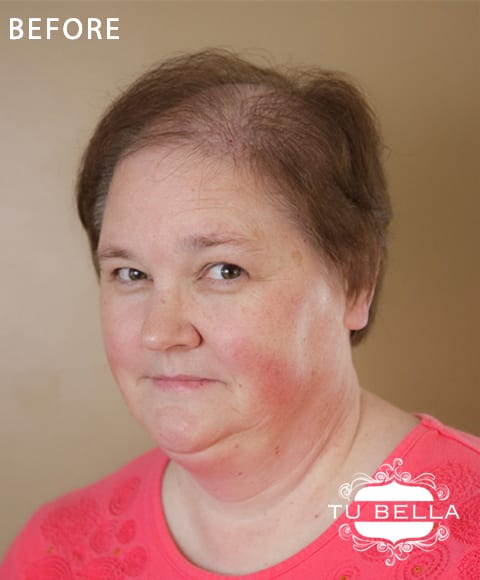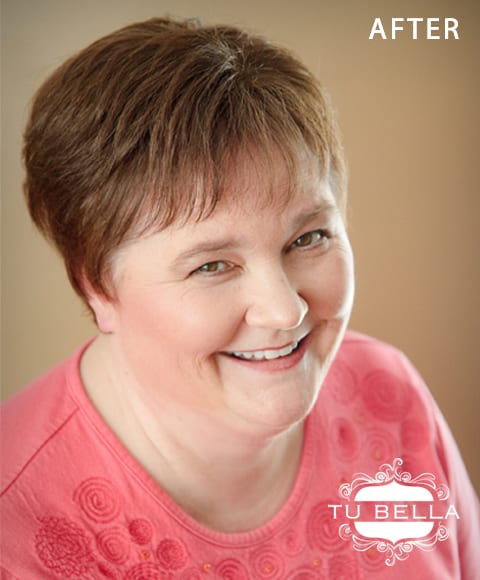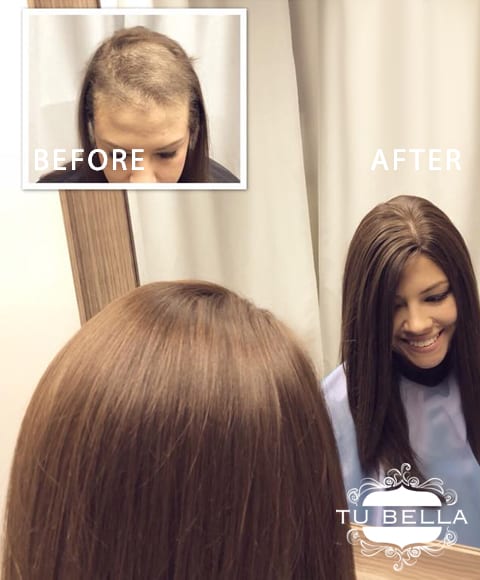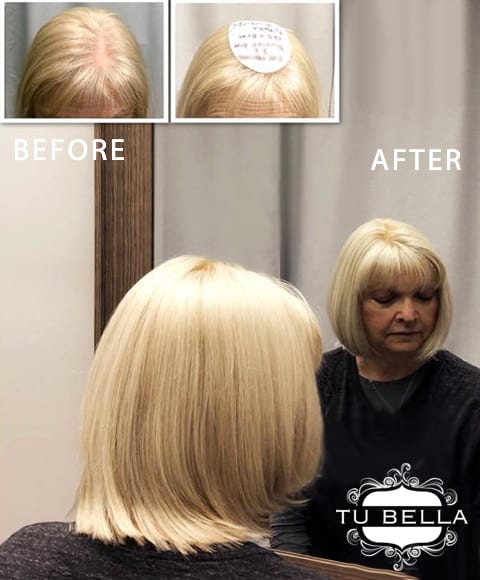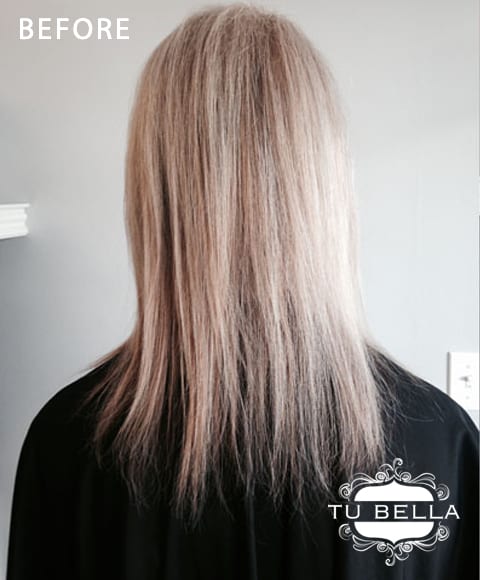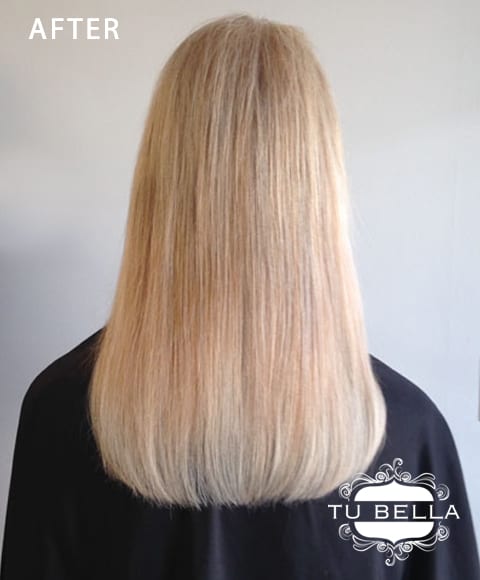Tu Bella
Tu Bella
 Melissa opened Tu Bella in 2002 after being inspired by her own mothers’ hair loss 15 years ago. It was at that time, Melissa found herself wanting to know more about hair loss and wanted to become a hair loss specialist. Melissa began her education by traveling to China and England to learn the craft of wig making. In 2004, she became a LOOK GOOD FEEL BETTER volunteer, which helps women with hair loss and skin effects from chemotherapy..
Melissa opened Tu Bella in 2002 after being inspired by her own mothers’ hair loss 15 years ago. It was at that time, Melissa found herself wanting to know more about hair loss and wanted to become a hair loss specialist. Melissa began her education by traveling to China and England to learn the craft of wig making. In 2004, she became a LOOK GOOD FEEL BETTER volunteer, which helps women with hair loss and skin effects from chemotherapy..
Melissa has taken great strides to offer clients the best in hair loss products that are available globally. She is working alongside Cesare Ragazzi, Follea, New Image Labs, Gemtress, Hair U Wear, Renee of Paris, and Theradome.
At Tu Bella we understand how difficult it may be to have hair loss due to a medical condition, medication, or genetics. Our mission is to help you find a hair solution that makes you feel and look beautiful inside and out.
Let’s Get Social
Review us on Google
Plan your visit, check the weather at our location
Get directions to our location here
Make sure we are going to be there for you, check our hours
Plan your visit, check the weather at our location
Get directions to our location here
Make sure we are going to be there for you,
check our hours
| Monday | Closed | |
| Tuesday | 12:00am – 7:00pm | |
| Wednesday | 9:30am – 4:00pm | |
| Thursday | 11:00am – 4:00pm | |
| Friday | 9:30am – 4:00pm | |
| Saturday | 9:00am – 1:00pm | |
| Sunday | Closed |
Featured Videos
Featured Videos
Reach out to us today
Reach out to us today
Our Services
- Custom Hair Replacement
- Photobiomodulation
- Hair Extensions
- Trichology
- Salon Services
- Wig Styling
- Hair Loss Control Products
- Toppers
- Wigs
- Hair Piece
- Non-Surgical Hair Replacement
- Toupee’
Location Features
- Complimentary Beverages
- Free WiFi Internet
- Free Parking
- By Appointment Only
- Credit Cards Accepted
FAQ’s
Click on a tab below to reveal the information.
Chemotherapy and radiation treatments, alopecia, thyroid disease, weight loss treatments, medications, women’s hormones,stress,menopause,nutritional deficiencies, polycystic ovarian syndrome, and lack of sleep .
The cap is the base of the wig that the hair is attached to. Wigs are available with different types of cap types and then hair is attached to the caps and sewn closely together in long strands. This string is then machine sewn, hand sewn or hand-tied horizontally onto the vertical lines of a wig cap.
Standard Cap
A standard or machined cap is the most common and most affordable cap design. The layers of hair are machine-sewed onto the cap, which has a closed lace layer at the crown. The hair has a specific style and the crown is often lightly teased or crimped so you cannot see down through to the cap at scalp area. This type of cap often gives the hair a natural lift at the crown for volume.
Capless Wig
A capless wig or combo is very similar to the standard cap. But instead of the closed lace layer at the crown, it has vertical lace strips with open spaces between the wefts. The open-wefting in the crown, back, and sides allows for maximum ventilation. This makes the cap lighter weight and cooler than a standard cap.
Monofilament Caps
Monofilament caps/ Hand-tied are constructed with using a thin, breathable nylon or polyester mesh material at the crown. It gives the illusion of your skin by partially revealing the scalp below. Hand-tied caps offer the most natural look as well as styling versatility because each hair is individually hand tied at the crown so the hair can be parted and brushed in any direction.
The entire wig may be hand tied, or the wig may have a monofilament crown with wefted sides and back. Monofilament wigs are an especially good choice for those with severe or total hair loss as the cap is soft, unlike cloth material, which can be itchy to those with sensitive scalps.
Alopecia is a condition of hair loss that can vary in severity, from patches that come and go to a permanent, total lack of hair. Many believe that this is why any choices that you consider must allow for exactly what is happening to you and how you want to look.
There are three main types of alopecia:
Androgenetic Alopecia: Sometimes referred to as female pattern thinning, this type of alopecia is generally attributed to hereditary and genetic factors. The hair becomes thinner all over the head. Unlike
Alopecia areata: patches of hair missing on the scalp and body
Alopecia totalis: baldness on the scalp only
Alopecia universalis: baldness on the scalp and body
CANCER. The word alone creates fear and confusion. Patients face not only the uncertainty of their disease, but also the anxiety of treatment—particularly hair loss.
This article provides facts about the relationship between chemotherapy, radiation therapy and hair loss. Its aim is to provide you with the information you need, using non-medical language, to understand what is happening to your hair, and why.
Chemotherapy consists of the administration of drugs that destroy rapidly reproducing cancer cells.
Cancer cells are some of the most rapidly reproducing cells in the body, but other cells, such as those
which contribute to the formation of hair shafts and nails, are also rapidly reproducing. Unfortunately, while chemotherapy drugs preferentially destroy cancer cells, the drugs also can destroy those cells responsible for normal growth of hair and nails. Cancer patients sometimes shed the hair and nails during treatment. Chemotherapy drugs are poisonous to the cells of the hair root responsible for hair shaft formation. Usually, the hair is lost rapidly in large quantities during treatment.
No hair growth stimulants, shampoos, conditioners, or other cosmetic treatments can prevent or retard chemotherapy related hair loss. The good news, however, is that once chemotherapy is completed, the hair usually grows back. This “grow back” period can take anywhere from 12 to 18 months.
What About Insurance?
Your insurance may cover the cost of a medical wig or hair prosthesis (prosthetic hair system). Be sure to check with your insurance agent to find out about your exact coverage and benefits.”
Hair Growth
Hair grows from the root, from the hair follicle, where a constant process of cell division occurs. Amino acids taken from blood feeding the follicle join with dividing cells, resulting in cell chains. Eventually these cell chains link up with one another, resulting in a long fiber. At this point, the nucleus of the original cell is dead, and the amino acids have formed into a hard keratin.
Keratin is a protein, and it is the substance our hair and nails are made from. It is a lifeless substance that results from the “pushing” of newly forming cells in the follicle. As the keratin protein is pushed out, our hair grows from the root. The growth of our hair follows a cyclical pattern that is one of the body’s most active “growing” processes: building shafts of hair for a period of time, and then resting.
Anti-cancer Drugs
Cancer is a condition of uncontrolled cell growth. Anti-cancer drug administration aims to reduce or stop this process. However, anti-cancer drugs act on both normal and cancerous cells, and are most likely to destroy cells that reproduce quickly. Hair follicles divide rapidly, which is why they are affected by chemotherapy. At any one time, about 85% of scalp hair follicles are reproducing.
Because a variety of drugs are used for chemotherapy treatment, hair loss depends upon the type prescribed and the dosage. Not all chemotherapy causes hair loss and, except in rare instances, hair loss is temporary. When treatment is completed, the hair follicles will resume processing amino acids from your blood and creating new hair for you.
Radiation Therapy
Radiation therapy employs high-energy radiation to inhibit the growth and division of cancer cells. It destroys all cells’ ability to grow and multiply in the area of application; however, cancer cells are more sensitive to radiation than normal cells. If treatment is applied as a cancer cell is about to reproduce it will prevent the cell from doing so, and the cell will die. Still, radiation therapy can sometimes affect normal tissue, causing side effects. One possible result of treatments to the head and neck is hair loss. Some or all of your hair in the area being treated may be lost. But, in most cases, hair growth will resume at the end of the treatment cycle.
Plan Ahead for Your Treatment
Assume you will lose all of your hair when you begin chemotherapy treatment. By doing so your advance planning will assist you considerably. (Custom made wigs and hair prosthetics may take from 6 weeks to 4 months to be delivered and made for you.)
Your first wig or hair prosthesis should duplicate your hair as closely as possible. (Be conservative in color, length, thickness and style.)
In chemotherapy related hair loss avoid the following: weaves, hair extensions, hair integration and hair intensifiers. You will require a full prosthesis and not a partial hairpiece.
Hair Loss Alternatives
There are several options for dealing with hair loss once it occurs. You may choose to cover your head with a hat, scarf or turban. Or, you may choose to replace your hair either with a medical wig or a prosthetic hair system.
If you choose to replace your hair, you’ll be happy to know that fake-looking wigs are a thing of the past. New technologies have made both human hair wigs and synthetic wigs appear highly realistic because they can be fitted to the shape of your head. Human hair wigs are typically more expensive and require more maintenance. Synthetic wigs are less expensive (although some special models are more expensive), and are easier to style and wash. Synthetic wigs also dry more quickly, and require less care.
Alopecia areata is a common condition that results in the loss of hair on the scalp and elsewhere. It usually starts with one or more small, round, smooth patches. It occurs in males and females of all ages, but young persons are affected most often.
Normally, hair follicles on the scalp are producing 30 meters of hair each day. In alopecia areata, the affected hair follicles slow down production drastically, become very small, and grow no hair visible above the surface for months or years. While in this hibernation-like state, the hair follicles remain alive below the surface and are ready to resume normal hair production whenever they receive the appropriate signal.
Some people develop only a few bare patches and re-grow them within a year, even without treatment. The scalp is the most commonly affected area, but the beard, or any hair bearing site, can be affected alone or together with the scalp. In some, the condition sprads and affects large areas of the scalp for long periods of time. In others, all hair on the scalp is lost-alopecia totalis-or all on the entire body is lost-alopecia universalis. No matter how widespread the hair loss, the hair follicles remain alive below the skin surface, and the possibility of hair re-growth remains.
FAQ’s
Click on a tab below to reveal the information.
Chemotherapy and radiation treatments, alopecia, thyroid disease, weight loss treatments, medications, women’s hormones,stress,menopause,nutritional deficiencies, polycystic ovarian syndrome, and lack of sleep .
The cap is the base of the wig that the hair is attached to. Wigs are available with different types of cap types and then hair is attached to the caps and sewn closely together in long strands. This string is then machine sewn, hand sewn or hand-tied horizontally onto the vertical lines of a wig cap.
Standard Cap
A standard or machined cap is the most common and most affordable cap design. The layers of hair are machine-sewed onto the cap, which has a closed lace layer at the crown. The hair has a specific style and the crown is often lightly teased or crimped so you cannot see down through to the cap at scalp area. This type of cap often gives the hair a natural lift at the crown for volume.
Capless Wig
A capless wig or combo is very similar to the standard cap. But instead of the closed lace layer at the crown, it has vertical lace strips with open spaces between the wefts. The open-wefting in the crown, back, and sides allows for maximum ventilation. This makes the cap lighter weight and cooler than a standard cap.
Monofilament Caps
Monofilament caps/ Hand-tied are constructed with using a thin, breathable nylon or polyester mesh material at the crown. It gives the illusion of your skin by partially revealing the scalp below. Hand-tied caps offer the most natural look as well as styling versatility because each hair is individually hand tied at the crown so the hair can be parted and brushed in any direction.
The entire wig may be hand tied, or the wig may have a monofilament crown with wefted sides and back. Monofilament wigs are an especially good choice for those with severe or total hair loss as the cap is soft, unlike cloth material, which can be itchy to those with sensitive scalps.
Alopecia is a condition of hair loss that can vary in severity, from patches that come and go to a permanent, total lack of hair. Many believe that this is why any choices that you consider must allow for exactly what is happening to you and how you want to look.
There are three main types of alopecia:
Androgenetic Alopecia: Sometimes referred to as female pattern thinning, this type of alopecia is generally attributed to hereditary and genetic factors. The hair becomes thinner all over the head. Unlike
Alopecia areata: patches of hair missing on the scalp and body
Alopecia totalis: baldness on the scalp only
Alopecia universalis: baldness on the scalp and body
CANCER. The word alone creates fear and confusion. Patients face not only the uncertainty of their disease, but also the anxiety of treatment—particularly hair loss.
This article provides facts about the relationship between chemotherapy, radiation therapy and hair loss. Its aim is to provide you with the information you need, using non-medical language, to understand what is happening to your hair, and why.
Chemotherapy consists of the administration of drugs that destroy rapidly reproducing cancer cells.
Cancer cells are some of the most rapidly reproducing cells in the body, but other cells, such as those
which contribute to the formation of hair shafts and nails, are also rapidly reproducing. Unfortunately, while chemotherapy drugs preferentially destroy cancer cells, the drugs also can destroy those cells responsible for normal growth of hair and nails. Cancer patients sometimes shed the hair and nails during treatment. Chemotherapy drugs are poisonous to the cells of the hair root responsible for hair shaft formation. Usually, the hair is lost rapidly in large quantities during treatment.
No hair growth stimulants, shampoos, conditioners, or other cosmetic treatments can prevent or retard chemotherapy related hair loss. The good news, however, is that once chemotherapy is completed, the hair usually grows back. This “grow back” period can take anywhere from 12 to 18 months.
What About Insurance?
Your insurance may cover the cost of a medical wig or hair prosthesis (prosthetic hair system). Be sure to check with your insurance agent to find out about your exact coverage and benefits.”
Hair Growth
Hair grows from the root, from the hair follicle, where a constant process of cell division occurs. Amino acids taken from blood feeding the follicle join with dividing cells, resulting in cell chains. Eventually these cell chains link up with one another, resulting in a long fiber. At this point, the nucleus of the original cell is dead, and the amino acids have formed into a hard keratin.
Keratin is a protein, and it is the substance our hair and nails are made from. It is a lifeless substance that results from the “pushing” of newly forming cells in the follicle. As the keratin protein is pushed out, our hair grows from the root. The growth of our hair follows a cyclical pattern that is one of the body’s most active “growing” processes: building shafts of hair for a period of time, and then resting.
Anti-cancer Drugs
Cancer is a condition of uncontrolled cell growth. Anti-cancer drug administration aims to reduce or stop this process. However, anti-cancer drugs act on both normal and cancerous cells, and are most likely to destroy cells that reproduce quickly. Hair follicles divide rapidly, which is why they are affected by chemotherapy. At any one time, about 85% of scalp hair follicles are reproducing.
Because a variety of drugs are used for chemotherapy treatment, hair loss depends upon the type prescribed and the dosage. Not all chemotherapy causes hair loss and, except in rare instances, hair loss is temporary. When treatment is completed, the hair follicles will resume processing amino acids from your blood and creating new hair for you.
Radiation Therapy
Radiation therapy employs high-energy radiation to inhibit the growth and division of cancer cells. It destroys all cells’ ability to grow and multiply in the area of application; however, cancer cells are more sensitive to radiation than normal cells. If treatment is applied as a cancer cell is about to reproduce it will prevent the cell from doing so, and the cell will die. Still, radiation therapy can sometimes affect normal tissue, causing side effects. One possible result of treatments to the head and neck is hair loss. Some or all of your hair in the area being treated may be lost. But, in most cases, hair growth will resume at the end of the treatment cycle.
Plan Ahead for Your Treatment
Assume you will lose all of your hair when you begin chemotherapy treatment. By doing so your advance planning will assist you considerably. (Custom made wigs and hair prosthetics may take from 6 weeks to 4 months to be delivered and made for you.)
Your first wig or hair prosthesis should duplicate your hair as closely as possible. (Be conservative in color, length, thickness and style.)
In chemotherapy related hair loss avoid the following: weaves, hair extensions, hair integration and hair intensifiers. You will require a full prosthesis and not a partial hairpiece.
Hair Loss Alternatives
There are several options for dealing with hair loss once it occurs. You may choose to cover your head with a hat, scarf or turban. Or, you may choose to replace your hair either with a medical wig or a prosthetic hair system.
If you choose to replace your hair, you’ll be happy to know that fake-looking wigs are a thing of the past. New technologies have made both human hair wigs and synthetic wigs appear highly realistic because they can be fitted to the shape of your head. Human hair wigs are typically more expensive and require more maintenance. Synthetic wigs are less expensive (although some special models are more expensive), and are easier to style and wash. Synthetic wigs also dry more quickly, and require less care.
Alopecia areata is a common condition that results in the loss of hair on the scalp and elsewhere. It usually starts with one or more small, round, smooth patches. It occurs in males and females of all ages, but young persons are affected most often.
Normally, hair follicles on the scalp are producing 30 meters of hair each day. In alopecia areata, the affected hair follicles slow down production drastically, become very small, and grow no hair visible above the surface for months or years. While in this hibernation-like state, the hair follicles remain alive below the surface and are ready to resume normal hair production whenever they receive the appropriate signal.
Some people develop only a few bare patches and re-grow them within a year, even without treatment. The scalp is the most commonly affected area, but the beard, or any hair bearing site, can be affected alone or together with the scalp. In some, the condition sprads and affects large areas of the scalp for long periods of time. In others, all hair on the scalp is lost-alopecia totalis-or all on the entire body is lost-alopecia universalis. No matter how widespread the hair loss, the hair follicles remain alive below the skin surface, and the possibility of hair re-growth remains.

